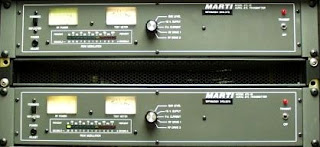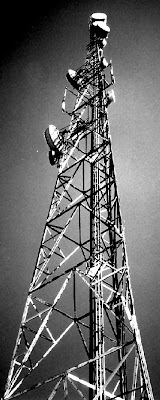 The Studio-to-Transmitter Link (STL) is what allows the tower to be in one place and the radio studio in another. In the early days of radio, the music, the DJ, the transmitter, antenna and tower all shared the same real estate. This was a big step forward as it allowed two things.
The Studio-to-Transmitter Link (STL) is what allows the tower to be in one place and the radio studio in another. In the early days of radio, the music, the DJ, the transmitter, antenna and tower all shared the same real estate. This was a big step forward as it allowed two things.1. Ideal rather than compromised tower placement
2. Clusters with shared towers and studios.
So you gotta take the good with the bad. The original form of an STL was a wire connection. This could be laid as a dedicated cable at great expense or more commonly supplied by the phone company, which in that era would have been American Telephone & Telegraph Company's Bell system.

Both would be an analog wired circuit, typically a dry pair of straight wire with no intermediate devices. They had no no transformers, compressors, or any kind of audio processing. The upside was that the lines could be used for AC or DC current. The downside was that frequency response was inconsistent especially over long distances.
Studio-to-transmitter links, and to some degree inter-city relays are familiar elements of most radio stations. They allow stations the flexibility to build their studios in locations that may be miles from the transmitter, allowing certain creature comforts or marketing opportunities. To all but those who must maintain them, they are a silent and sometimes forgotten step in the transmission chain
The legacy form of an STL is a wired path. Traditionally supplied by the local telephone company, an analog wired circuit was once the most common form of STL. The most basic type of circuit is a dry pair. This is a straight-wire path between two points. There are no active or passive devices between the source and destination. This type of circuit is also sometimes called a burglar-alarm circuit because it is commonly used for signaling by monitoring companies. Because there are no transformers or equalizers, these lines can pass ac and dc voltages. Their frequency response can be unpredictable and will suffer at long distances.
Modern STL is wildly more advanced using digital data, point-to-point microwave connections, dedicated T1 lines, or a broadcast on another licensed radio frequency ouside the AM & FM bands usually in the 950 Mhz band. Most stations using an STL have a transmitter-to-studio link (TSL) that returns transmitter data. Both the STL and TSL are considered broadcast auxiliary services (BAS) by the FCC and require separate licensing from the CP under their facility ID.




No comments:
Post a Comment